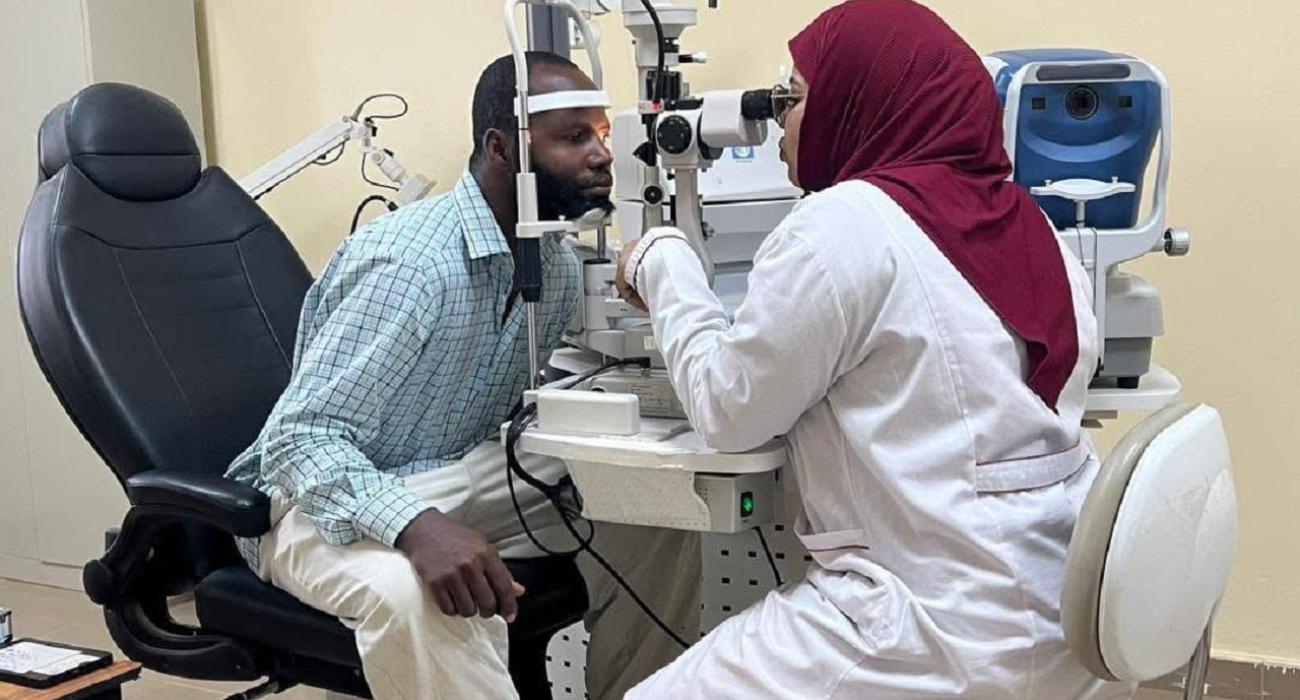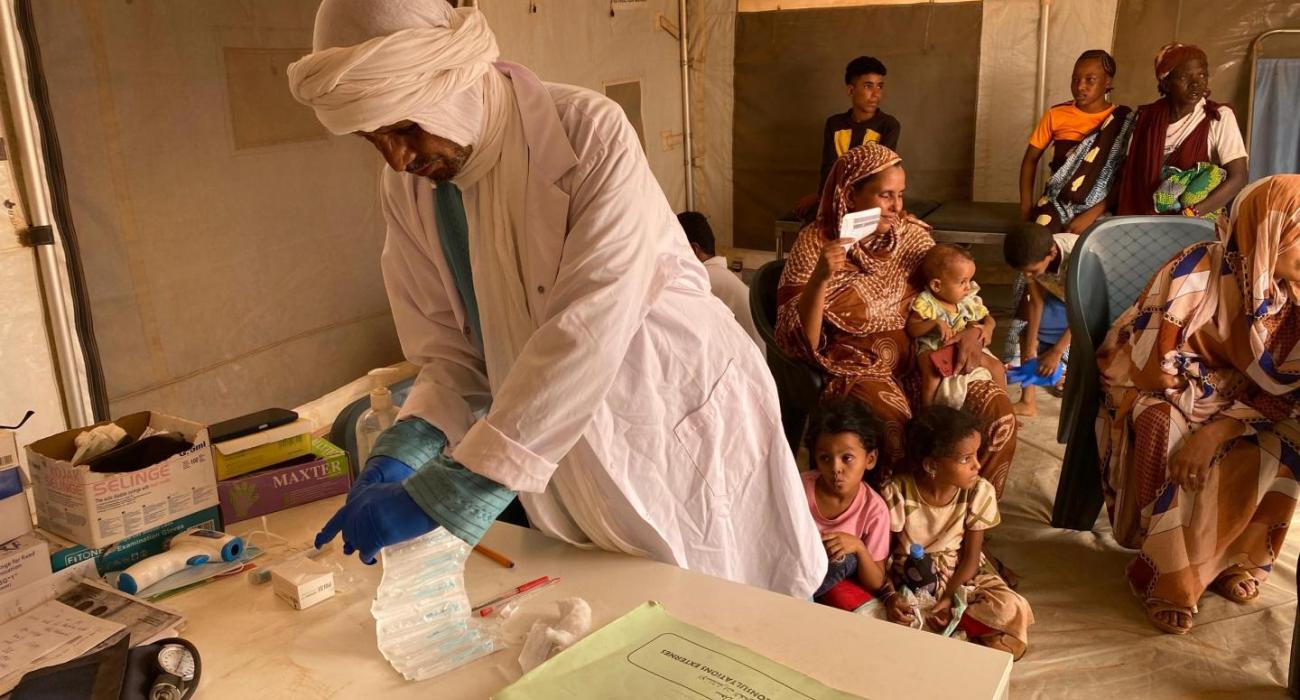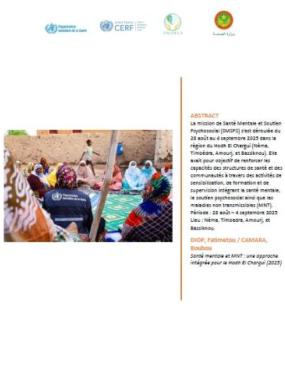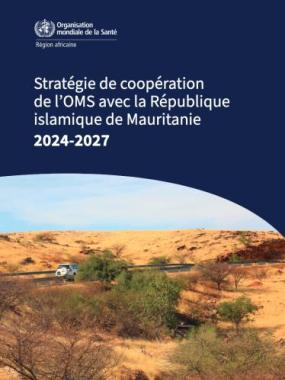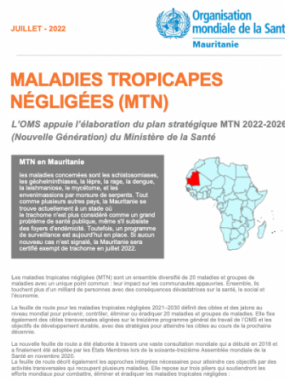| Indicateur | Valeur récente | Année |
|---|---|---|
| Total Population | ≈ 5,17 millions (est. 2024) | 2024 |
| Revenu national brut par habitant (PPA) | ≈ 2 120 $ (PIB nominal p.c.) | 2023 |
| Espérance de vie à la naissance (H/F) | Hommes : 62,8 ans – Femmes : 67,8 ans – Moyenne : 65,2 ans | 2022 |
| Espérance de vie en bonne santé (HALE) | ≈ 60,4 ans | 2021 |
| Probabilité de décéder avant 5 ans (‰) | ≈ 39,2 décès pour 1 000 naissances | 2022 |
| Probabilité de décès entre 15–60 ans (H/F) | M : ≈ 0,19 % (≈190 ‰) – F : ≈ 0,19 % (≈190 ‰) | ~2020 |
| Dépense totale de santé par habitant | 89 $ (USD) | 2021 |
| Dépenses de santé (% du PIB) | 4,1 % | 2021 |
Mauritania
Renseignements de Pays
Données & statistiques
Country Health Topics
Le Profil de Santé de la Mauritanie présente un aperçu de la situation et des tendances des problèmes de santé prioritaires, ainsi que le profil du système de santé, y compris une description des cadres institutionnels, des tendances de la réponse nationale, et des principaux problèmes et défis. Son objet est de promouvoir la prise de décisions fondées sur des bases factuelles dans le domaine de la santé, en recourant à une analyse approfondie et rigoureuse de la dynamique de la situation sanitaire et du système de santé du pays.
Le Profil de Santé du Pays est mis à jour sur une base régulière. Actuellement, les données sur les sujets de santé ne sont pas disponibles.
Neglected Tropical Diseases (NTDs) and Disease Elimination
- Trachoma: Mauritania was validated by WHO in May 2025 as having eliminated trachoma as a public health problem — the 7th African country to achieve this milestone.
- Guinea worm disease (dracunculiasis): Eliminated in 2009.
- Leprosy: Significant decline; only 17 new cases in 2023 compared to 42 in 2010. Treatment success rate >90%.
Communicable Diseases & Epidemic Outbreaks - Rift Valley Fever (RVF): In 2022, 47 human cases (23 deaths – ~49% case fatality rate) across 9 regions. Animal infections were reported in 12 regions.
- Malaria: Rising concerns about Plasmodium vivax and Aedes vector spread; needs enhanced surveillance.
- Measles, diphtheria, pertussis: Recent outbreaks recorded, especially in the Hodh El Chargui region (refugee-hosting area), requiring urgent health response.
Maternal and Child Health - Under-five mortality rate: Approximately 38 deaths per 1,000 live births (2022).
- Maternal mortality: Estimated at 766 maternal deaths per 100,000 live births (2020).
- Immunization coverage: High for DTP3 (~90%), but measles vaccine coverage remains lower (~24%); leading to outbreaks.
Immunization Programme - Routine Immunization: High coverage for key vaccines (DTP3 > 90%) thanks to Gavi support, but gaps persist for others like measles, HPV, and newborn BCG in some districts.
- Vaccine-preventable disease outbreaks: Mauritania has experienced recurrent measles and diphtheria outbreaks due to immunity gaps, particularly among refugee and nomadic populations.
Recent developments: Introduction of the hexavalent vaccine in 2025 aims to improve protection against six childhood diseases in a single shot.
Non-Communicable Diseases (NCDs) & Risk Factors
- Obesity and diabetes: High prevalence, especially among women.
- Obesity: ~21% (women), ~8.2% (men)
- Diabetes: ~10.7% (women), ~9.8% (men)
- Tobacco use: National legislation has reduced tobacco consumption.
- Mental health: The country has a Neuropsychiatric Center in Nouakchott, but national access to mental health services is still very limited.
Environmental Health & Sanitation
- Diarrhea in children under 5: Estimated 2,150 annual deaths, mainly due to poor water and sanitation conditions.
- Air quality and environmental exposure: Increasing concerns in urban and rural areas. Sanitation infrastructure is insufficient in many parts of the country.
Health Emergencies and Preparedness
- COVID-19: Mauritania responded quickly during the first wave. By the end of 2021, there were ~41,000 confirmed cases and 866 deaths.
- Health emergency preparedness: Strengthened post-COVID, though gaps in surveillance and logistics remain.
Additional Info
Access to Medicines
- Essential Medicines: While Mauritania maintains a national list of essential medicines, availability remains inconsistent, especially in remote and refugee-hosting areas like Hodh El Chargui.
- Supply chain challenges: Weaknesses in logistics and supply management often lead to stockouts in both public and humanitarian settings.
- Affordability: The out-of-pocket cost for medicines is a major barrier to access for vulnerable populations.
Laboratory Capacity
- National Reference Laboratory (LNR): Located in Nouakchott, the LNR plays a central role in diagnosing epidemic-prone diseases (e.g. diphtheria, measles, COVID-19).
- Decentralization gaps: Most peripheral and regional health facilities lack basic diagnostic capacities. Specimen transport systems are weak, causing delays in confirmation and response.
- Emergency support: During health emergencies, WHO and partners often deploy mobile labs or support temporary diagnostic solutions.
Événements
Publications
Mauritania Office Contact
Le Représentant de l'OMS en Mauritanie est Prof. Charlotte Faty NDIAYE
Représentant de l'OMS en Mauritanie / Nouakchott
BP : 320
ILOT K 140-141 Tevragh-Zeina
Route de la Corniche Ouest
Tél : +222 45 25 24 02 / +222 45 29 52 25
E-mail: afwcomr [at] who.int (afwcomr[at]who[dot]int)

